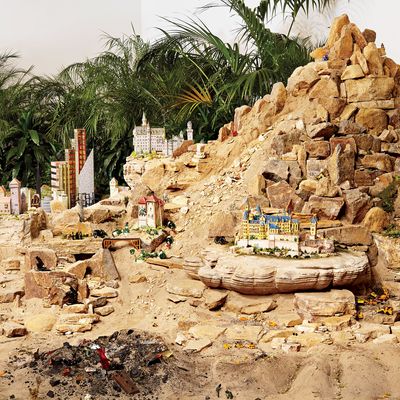
The artist Lawrence Weiner once said that art shouldn’t just be something that messes up a person’s day—it should “fuck up their whole life.” Artist Chris Burden did that to me. Twice! The first time was on May 7, 1974, in his Chicago performance Velvet Water. For five minutes, a small group of us sat on metal folding chairs and watched a video monitor while, in an adjacent room, Burden relentlessly dunked his head in a filled-up sink, trying to inhale the oxygen-rich water. We sat stupefied, paralyzed, until he seemed to pass out, and the monitor went dark, and that was it. Less than a year later, at Doomed, I watched Burden enter Chicago’s Museum of Contemporary Art and lie down beneath a sheet of tilted glass and a ticking clock nearby. Then he did nothing—didn’t move, eat, drink, speak. I left after a few hours. The next afternoon, I heard he was still there. Hmmm, weird. The day after that, I heard that he still hadn’t moved. This thing had gone from weird to psycho. I returned to the museum. A handful of people were sitting there transfixed, freaked out. In the Sun-Times, Roger Ebert quoted a museum employee saying, “It’s a really strange scene here right now.” I’ll say it was. Finally, 45 hours into this excruciating thing, fearing uremic poisoning or dehydration, my friend Dennis O’Shea placed a pitcher of water next to Burden. Just like that, the artist got up, fetched a hammer from another room, and smashed the clock. The performance was over. So were lots of my ideas about art. Burden told Ebert, “I thought, My God … are they going to leave me here to die?”
That’s how up-for-grabs things were in the seventies. Painting wasn’t the only medium that was supposedly dead—art might have been, too, and everyone was doing anything to open it up. The great Suprematist Kazimir Malevich’s ideas of “new beauty” were afoot anew. Artists were dematerializing the art object via conceptualism and performance and doing all sorts of wild things with their bodies. Marina Abramovic worked as a prostitute during her show; Vito Acconci masturbated under a gallery floor; Joseph Beuys lived in a gallery with a live coyote; Jack Goldstein buried himself alive. Burden was part of this revolutionary aesthetic palace coup. But his art combined a stripped-down, poetic elegance with the insurrectionary shock of Duchamp’s urinal. Now, thanks to its extraordinary institutional dedication to exhibiting artists that other local museums have overlooked, the New Museum is vividly delivering Burden’s mind-changing, big-picture art to a broad audience.
Better, more daring, and less predictable yet, it does this counterintuitively, playing down the early performances and concentrating instead on the work that followed. On the museum’s small fifth floor, there are two notebooks documenting Burden’s early work. The rest of the museum and even the outside of the building is mostly outfitted with the large-scale sculptures Burden made after 1980. That helps brush off the silly idea that after 1980 Burden’s best artistic days were behind him and the increasingly tiresome trope that the seventies were the last days of purity.
Be forewarned, Burden’s post-1980 art isn’t about any of the feel-good bromides the art world sometimes falls back on. He is a pragmatist. For him beauty is what works. His art is beautiful the way a perfect swing in baseball is said to be. He likes to plumb big ideas: gravity, war, the catalytic conversion of one activity into another, the energy contained in objects. The subtext of much of Burden’s thinking is delving into the ways we may be using the forces of nature to engineer our own extinction.
After perusing Burden’s notebooks (note that his writing style is one of the most brilliantly condensed and clear of any artist’s), you can head down to the fourth floor, where you’re greeted by one of his unwieldy, even ugly sculptures. The Big Wheel (1979) is an eight-foot, 6,000-pound cast-iron flywheel mounted on a wooden pyramidlike structure. A real motorcycle is placed so that its rear wheel can make contact with the big iron one. A couple of times a day, a rider mounts the bike, shifts it so that the rear wheel makes contact with the flywheel, and revs the bike up to its top speed. Then the bike is turned off and pushed away. The iron wheel ominously spins for up to two hours. You are seeing oil chemically and mechanically converted into movement, flirting with perpetual motion, and on the edge of destruction—and nothing actually goes anywhere. Burden describes the piece as a “Neanderthal atomic bomb.”
Nearby is one of the greatest illustrations of creative and destructive power you’ll ever see. Beam Drop (1984) is a video documentation of a giant crane dropping about 60 large steel I-beams into a pit of wet concrete from more than 100 feet up. It’s shocking to see so much mass, density, and energy converted instantaneously into a Jackson Pollock–esque sculpture, an abstraction of annihilation. Few artists have brought play, presence, magnitude, hostility, and pleasure into such close proximity.
On the second floor is the apocalyptic apotheosis of this sort of play. In the sprawling A Tale of Two Cities, Burden lays out tons of sand, rocks, and plants on the museum floor to depict two city-states at perpetual war with each other. He uses more than 5,000 toy soldiers, robots, weapons, boats, tanks, missiles, bullets, and whatnot from America, Europe, and Japan. (Burden supplies binoculars, if you wish to zoom in from your God’s-eye view.) A Tale of Two Cities gives us a topology of cascading consequences, a gigantic circulation of flesh, a hyperbolic psychological grand human narrative, and simple twists of geographical fate. It’s his Iliad, and it isn’t pretty. But it works.
Chris Burden: Extreme Measures, New Museum of Contemporary Art, Through January 12.
*This article originally appeared in the October 28, 2013 issue of New York Magazine.




